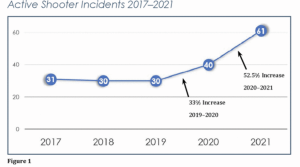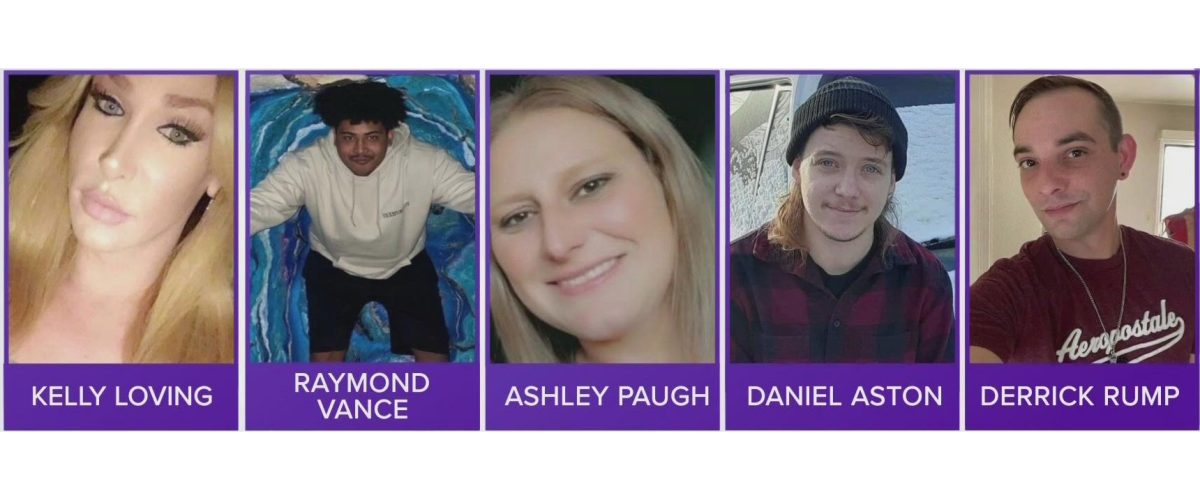Just before midnight on Saturday, Nov. 19, a gunman entered Club Q — an LGBTQ nightclub in Colorado Springs, Colo. — and opened fire on its guests. Five people were killed and 25 others were injured before a clubgoer subdued the gunman by grabbing the attacker’s gun and hitting him with it. Another clubgoer then subdued the gunman until police arrived on the scene.
Among social media posts expressing grief about this event, many commentators — once again —are calling for legislative change to prevent mass shootings like this.
According to the Gun Violence Archive, there have been 603 mass shootings in the United States during 2022. In 2020, there were 611.
Although there is a lack of consensus as to its exact definition, a “mass shooting” is defined by Health Affairs as a tragedy that results in multiple victims of firearm-related violence during a single incident, typically (but not necessarily) in one particular public location. These events are random, unlike other conventionally motivated crimes such as gang violence or armed robbery.
 An Active Shooter Incident, according to the FBI, is defined as “one or more individuals actively engaged in killing or attempting to kill people in a populated area” utilizing a firearm. The “active” aspect of the definition intends to note its ongoing nature, and “the potential for the response to affect the outcome.” Using this definition, the FBI designated 61 shootings as Active Shooter Incidents in 2021, a 52.5% increase from 2020.
An Active Shooter Incident, according to the FBI, is defined as “one or more individuals actively engaged in killing or attempting to kill people in a populated area” utilizing a firearm. The “active” aspect of the definition intends to note its ongoing nature, and “the potential for the response to affect the outcome.” Using this definition, the FBI designated 61 shootings as Active Shooter Incidents in 2021, a 52.5% increase from 2020.
These definitions are similar, and it is sometimes hard to track the exact number of these incidents because agencies may disagree on how individual incidents should be categorized.
In general, incidents called mass shootings typically involve four or more wounded people (sometimes including the perpetrator), while Active Shooter Incidents (such as those identified by the FBI) do not necessarily have victims, or can be defined as such with fewer than four wounded people. Still, it may be difficult to distinguish between the two, since unlike an Active Shooter Incident, there is no official definition of a mass shooting.
Regardless of these differences, all the data collected seems to agree that these incidents are a problem in the United States that needs to be addressed. The data also show there are many other ways gun-related deaths occur in the United States.
According to the U.S. Centers for Disease Control, in 2020, most gun-related deaths were a result of suicide (24,292). A study published in the American Journal of Public Health, identified a strong relationship between high levels of gun ownership and high rates of suicide using firearms among both men and women.
 When compared to other countries, a significantly larger proportion of murders in the United States are carried out with guns than with other weapons or methods.
When compared to other countries, a significantly larger proportion of murders in the United States are carried out with guns than with other weapons or methods.
But what to do about all this? Americans have differing opinions — strongly different opinions.
According to surveys done by Pew Research Center, a narrow majority (53%) of all Americans say gun laws should be more strict than they are now, while 32% believe gun laws “are about right” and 14% believe they should be less strict than now.
There are deep divisions between Republicans and Democrats on these views. Among Republicans and Republican-leaning Americans, only 20% believe gun laws should be stricter, while 53% like them as is. The rest, 27%, believe gun laws should be reduced.
Among Democrats and Democratic-leaning Americans, 81% believe gun laws should be stricter. On the contrary, only 15% like them as is, and 4% want them to be reduced.
 A similar distribution is seen when these groups are asked what would happen “if it was harder for people to legally obtain guns” in America: A majority (65%) of Republicans think it would make no difference, while 20% believe it would reduce mass shootings and 15% believe the number of mass shootings would increase. In contrast, a majority (73%) of Democrats believe the number of mass shootings would be reduced, while 23% believe nothing would change, and only 3% believe there would be more mass shootings.
A similar distribution is seen when these groups are asked what would happen “if it was harder for people to legally obtain guns” in America: A majority (65%) of Republicans think it would make no difference, while 20% believe it would reduce mass shootings and 15% believe the number of mass shootings would increase. In contrast, a majority (73%) of Democrats believe the number of mass shootings would be reduced, while 23% believe nothing would change, and only 3% believe there would be more mass shootings.
Additionally, when asked what would happen “if more Americans owned guns,” the parties are diametrically opposed. If more Americans owned guns, 56% of Republicans believe crime would reduce, while 55% of Democrats believe crime would increase.
Last, when asked what would happen “if it was harder for people to legally obtain guns,” 62% of young adults believe there would be fewer mass shootings, compared to other age groups in which smaller chunks of people share the same view. This same pattern is found when comparing urban, suburban and rural Americans — with urban Americans being more likely to say stricter gun laws would reduce mass shootings.
But while there are divisive political opinions about gun rights and legislation, for many the shooting at Club Q was about something else: Violence against the LGBTQ community.
At Temple Beit Torah in Colorado Springs, a Sunday interfaith service is held each week. On Nov. 20, the service was intended to be in observance of the Transgender Day of Remembrance, a day for mourning the lives of transgender persons lost due to hateful violence. However, given news of the shooting just hours before, the service was turned into a vigil for those killed at Club Q.
Although Club Q was not exclusive to transgender persons, and not all the victims were transgender, Pastor Alycia Erickson told Colorado Public Radio it was important to recognize and include this violence in their service because “there are transgender people included in the people who were also shot” that night. She also emphasized the importance of allowing a space for the community of Colorado Springs to grieve, saying that spaces like this help those in the LGBTQ community “who have felt cast aside by their religion” feel supported during this difficult time.
According to the Human Rights Campaign’s 2020 report on fatal violence against transgender and gender-nonconforming Americans, there were 37 fatalities as a result of violence against transgender and gender-nonconforming Americans that year. And 85% of these victims were people of color, 84% were women, and 78% were transgender women of color.
Gun violence certainly affects more than just the LGBTQ community, but the recent shooting at Club Q is a reminder for Americans that being gay or transgender can be especially dangerous.
In a recent article for BNG, Susan Shaw calls upon Christians to take action against acts of violence like this and be brave enough to stand against violence and oppression even if it costs social or political reputation.
These are the victims of Club Q Nightclub shooting:
- Daniel Davis Aston, a bartender and entertainer at Club Q. He was 28 years old. Daniel was transgender.
- Derrick Rump, a bartender at Club Q. He was 38 years old.
- Kelly Loving, who was celebrating her 40th birthday the night of the shooting. Kelly was transgender.
- Ashley Paugh, a guest at the nightclub the night of the shooting. She is survived by her husband and 11-year-old daughter.
- Raymond Green Vance, who was with his girlfriend at Club Q celebrating a friend’s birthday. He was 22 years old.
Related articles:
It’s a short distance from your Thanksgiving table jokes to queer people being shot dead | Opinion by Amber Cantorna
If you want to offer thoughts and prayers after the latest massacre at a queer club, do so with your actions | Opinion by Susan Shaw


